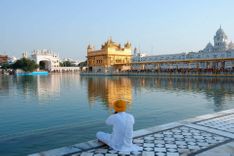#12 Vagator
Barely a few kilometers of clifftops and parched grassland separate Anjuna from the southern fringes of Vagator. Known as one of the best beaches in Goa.
Spread around a tangle of winding back lanes, it’s a more chilled, undeveloped resort that appeals, in the main, to southern European beach bums who return year after year. With the red ramparts of Chapora fort looming above it, Vagator’s broad sandy beach — known as “Big Vagator”—is” undeniably beautiful.
That said, if you’re looking for a place to find peace, this isn’t it, being a prime stop for bus parties of domestic tourists. For more seclusion, head to the next beach south. Backed by a steep wall of crumbling palm-fringed laterite, Little (or “Ozran”) Vagator Beach is actually a string of three contiguous coves.
To reach them, you have to walk from where the buses park above Big Vagator. Alternatively, drive to the end of the lane running off the main Chapora–Anjuna road towards the Nine Bar.
From here, footpaths drop sharply down to a wide stretch of level white sand — look for the mopeds and bikes parked at the top of the cliff. The southernmost—dubbed “Spaghetti Beach”—is the prettiest, with a string of well-established shacks.
How to get to Vagator
Vagator is around 6 miles (10 km) from Mapusa and 25 miles (40 km) from Dabolim Airport. Taxis from Panaji or the airport are the most direct option. Public buses run to Vagator village from Mapusa, and from there it’s a short walk to Big Vagator. Little Vagator requires more navigation—follow the road toward Nine Bar, then look for scooters and mopeds parked at the cliff’s edge. That’s where the footpaths to the coves begin.
When to visit Vagator
November through February brings the most comfortable weather for this Goa beach. December and January are the busiest months, especially with events and parties happening nearby. October and March can be a good balance—fewer people but still nice conditions. Sunsets here are particularly striking thanks to the reddish cliffs, and weekdays are your best bet if you're hoping to avoid crowds.

















